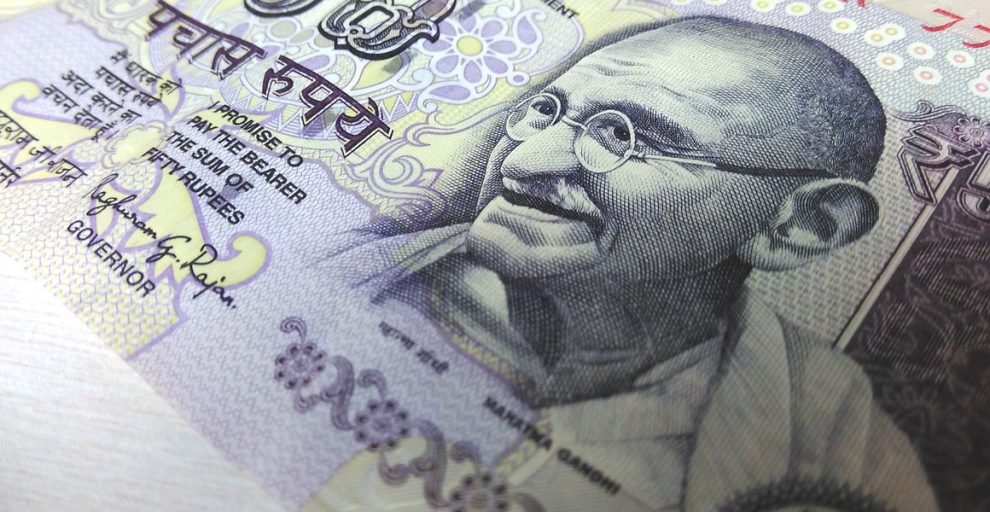Exchange daily course between Indian rupees (INR) and USA Dollars (USD) is given on this page.
In first drop down menu choose Indian rupee (INR). In second choose USA Dollar (USD). If you enter 1 Indian rupee (INR) for example, you will receive its equivalent in USA Dollars (USD), Euros, turkish Liras, Dinars, Japanese Jean, Rubles etc.
You can enter any arbitrary amount of currencies below. Rates are updated daily by Swiss National Bank.
Date: Wednesday 2nd of July 2025 12:01:29 PM
You can also convert USA Dollars to Indian rupees (INR). Insert values of rupees or Dollars, find than opposite values for Dollars or Euros, in second row and automatically you will get calculated value of another banknotes. The currency data are updated daily. We hope that ratio will be optimal for your business. Enjoy in work and calculations!
Indian rupees (INR)
The rupee (code: INR) is the currency of India. The issuance of the currency is controlled by the Reserve Bank of India. The most commonly used symbols for the rupee is Rs. The ISO 4217 code for the Indian rupee is INR. On 5 March 2009 the Indian Government announced a contest to create a symbol for the Rupee. The modern rupee is subdivided into 100 paise (singular paisa).
Paradox Rupee Dollar exchange rate today is everyday story for big forex trading agencies.
Here you can make some analyses for Rupee Dollar values on daily level. In finance, the exchange rates of Ruppe Dollar (also known as the foreign-exchange rate, forex rate or FX rate) between two currencies specifies how much one currency, in our example Indian Rupee is worth in terms of the USD Dollars. It is the value of a foreign nation’s currency in terms of the home nation’s currency.
Note: Practice, and convert Indian rupees (INR) to the European euro (EUR) by our converter on the top
For example an exchange rate of 100 Indian rupees (INR) and convert them to the European euro (EUR). The foreign exchange market is one of the largest markets in the world. By some estimates, about 3.2 trillion USD worth of currency changes hands every day.
The spot exchange rate refers to the current exchange rate. The forward exchange rate refers to an exchange rate that is quoted and traded today but for delivery and payment on a specific future date.
Security features
Watermark — White side panel of notes has Mahatma Gandhi watermark.
Security thread — All notes have a silver security band with inscriptions visible when held against light which reads Bharat in Hindi and RBI in English.
Latent image — Higher denominational notes (Rupees 20 onwards) display the note’s denominational value in numerals when held horizontally at eye level.
Microlettering — Numeral denominational value is visible under magnifying glass between security thread and latent image.
Fluorescence — Number panels glow under ultra-violet light.
Optically variable ink — Notes of Rs. 500 and Rs. 1000 have their numerals printed in optically variable ink. Number appears green when note is held flat but changes to blue when viewed at angle.
Back-to-back registration — Floral design printed on front and back of note coincides and perfectly overlap each other when viewed against light.
EURion constellation
Officially, the Indian rupee has a market determined exchange rate. However, the RBI trades actively in the USD/INR currency market to impact effective exchange rates. Thus, the currency regime in place for the Indian rupee with respect to the US dollar is a de facto controlled exchange rate. This is sometimes called a dirty or managed float.
Other rates such as the EUR/INR and INR/JPY have volatilities that are typical of floating exchange rates. It should be noted, however, that unlike China, successive administrations (through RBI, the central bank) have not followed a policy of pegging the INR to a specific foreign currency at a particular exchange rate. RBI intervention in currency markets is solely to deliver low volatility in the exchange rates, and not to take a view on the rate or direction of the Indian rupee in relation to other currencies.
Also affecting convertibility is a series of customs regulations restricting the import and export of rupees. Legally, foreign nationals are forbidden from importing or exporting rupees, while Indian nationals can import and export only up to 5000 rupees at a time, and the possession of 500 and 1000 rupee notes in Nepal is prohibited.
RBI also exercises a system of capital controls in addition to the intervention (through active trading) in the currency markets. On the current account, there are no currency conversion restrictions hindering buying or selling foreign exchange (though trade barriers do exist). On the capital account, foreign institutional investors have convertibility to bring money in and out of the country and buy securities (subject to certain quantitative restrictions).
Local firms are able to take capital out of the country in order to expand globally. But local households are restricted in their ability to do global diversification. However, owing to an enormous expansion of the current account and the capital account, India is increasingly moving towards de facto full convertibility.
-
Recommendation:
















Add Comment